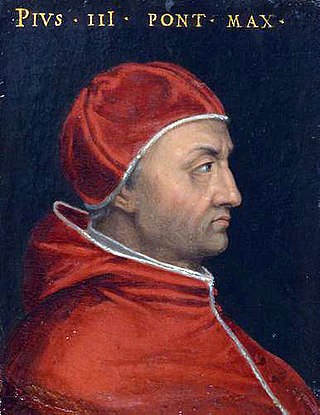
Pope Pius III, born Francesco Todeschini, was head of the Catholic Church and ruler of the Papal States from 22 September 1503 to his death. At just twenty-six days, he had one of the shortest pontificates in papal history.

Pietro Accolti, known as the "cardinal of Ancona", was an Italian Roman Catholic cardinal and judge of the Roman Rota.
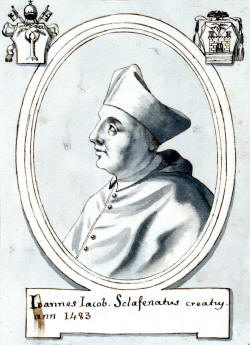
Giovanni Giacomo Sclafenati (Schiaffinati) was an Italian cardinal of the Catholic Church. He was bishop of Parma in Italy.
Flavio Orsini was a papal bureaucrat, an Italian bishop, and a cardinal of the Catholic Church. He was son of Ferdinando Orsini, 5th duke of Gravina; and Beatrice Ferrillo, daughter and heiress of Giovanni Alfonso Ferrillo, Conte di Muro Lucano.
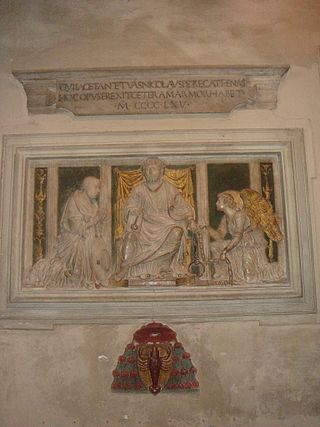
Andrea di Cristoforo Bregno (1418–1506) was an Italian Renaissance sculptor and architect of the Early Renaissance who worked in Rome from the 1460s and died just as the High Renaissance was getting under way.

Giovanni Antonio Sangiorgio was an Italian canon lawyer and Cardinal. Agostino Oldoino calls him the leading jurisconsult of his age. Kenneth Pennington has called him one of the ‘last two great commentators on feudal law’.
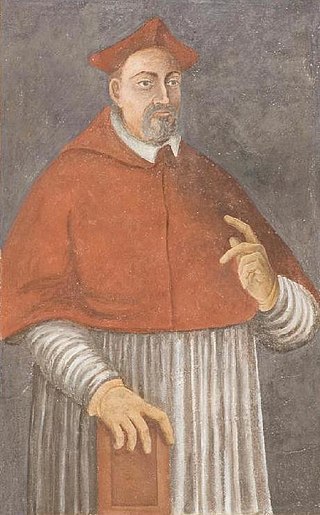
Francesco Pisani was an Italian Cardinal, born in Venice, the son of Alvise Pisani the noted banker, who was Procurator of S. Mark's, a member of the Council of Ten, and a Councilor of the Doge of Venice; and Cecilia Giustinian. He had a brother named Giovanni (Zuan), who also became Procurator of S. Marks' and was a Venetian diplomat; he was married to the sister of Doge Andrea Gritti. He was a strong supporter of the alliance between Venice, France and the Papacy, called the League of Cognac. He shared the imprisonment of Pope Clement VII in the Castel S. Angelo during the Sack of Rome and its aftermath. He spent eighteen months in exile in Naples while Clement made his peace with the Emperor Charles V.

The Italian Catholic Diocese of San Marino-Montefeltro was until 1977 the historic Diocese of Montefeltro. It is a Latin suffragan of the Archdiocese of Ravenna-Cervia. The current diocese includes all the parishes of San Marino.

The 1458 papal conclave, convened after the death of Pope Callixtus III, elected as his successor Cardinal Enea Silvio Piccolomini who took the name Pius II.

Pope Callixtus III created nine cardinals in two consistories.
Guillermo Raimundo de Vich y de Vallterra was a cardinal in the Catholic Church.

Miguel da Silva was a Portuguese nobleman, the second son of Diogo da Silva, 1st Count of Portalegre and of his wife Maria de Ayala, a Castilian noblewomen. He was ambassador of the king of Portugal to several popes, and papal ambassador to the Emperor and others.

The 1264–65 papal election was convened after the death of Pope Urban IV and ended by electing his successor Pope Clement IV. It met in Perugia, where Urban IV had taken refuge after being driven out of Orvieto. He had never been in Rome as Pope, but spent his entire reign in exile. It was the second election in a row where a pope was elected in absentia; the phenomenon would be repeated in the Conclave of 1268–1271, and again in the Conclave of 1292–1294. In the last two cases, the person elected was not even a Cardinal.

Juan de Mella was a Spanish Roman Catholic bishop and cardinal.
Giovanni Castiglione (1420–1460) was an Italian Roman Catholic bishop and cardinal.
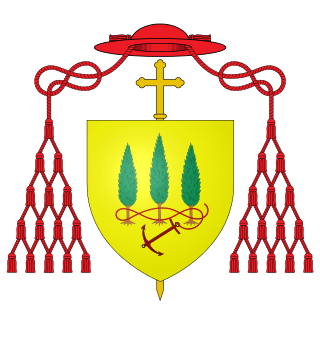
Angelo Capranica was an Italian Roman Catholic bishop and cardinal.

Juan de Vera was a Spanish Roman Catholic bishop and cardinal.

Niccolò Brancaccio was born in the Kingdom of Naples, perhaps in Naples itself. He was Archbishop of Bari and then Archbishop of Cosenza, while serving in the Roman Curia in Avignon. He became a cardinal of the Avignon Obedience in 1378, and was Cardinal Priest of Santa Maria in Trastevere and then Cardinal Bishop of Albano. He participated in the Council of Pisa in 1409, and was one of the electors of Pope Alexander V and of Pope John XXIII.

The papal conclave of March–April 1605 was convened on the death of Pope Clement VIII and ended with the election of Alessandro Ottaviano de' Medici as Pope Leo XI on 1 April 1605. It was the first of two papal conclaves in 1605, with Leo dying on 27 April 1605, twenty-six days after he was elected, and the conclave to elect his successor being held in May. The conclave saw conflict regarding whether Cesare Baronius should be elected pope, and Philip III of Spain, the Spanish king, excluded both Baronius and the eventually successful candidate, Medici. Philip's exclusion of Medici was announced by Cardinal Ávila after his election to the papacy, and the other cardinals did not view it as valid since Medici had already been elected pope.

The papal conclave of May 1605 was convened on the death of Pope Leo XI and ended with the election of Camillo Borghese as Pope Paul V on 16 May 1605. It was the second of two papal conclaves in 1605, with Leo dying on 27 April 1605, twenty-six days after he was elected in the March–April 1605 papal conclave.














